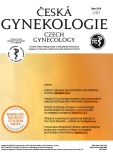Radiofrequency endometrial ablation – new possibility of heavy menstrual bleeding conservative treatment
Authors:
Martin Huser
; Z. Papíková; M. Dziakova; R. Hudeček; P. Ventruba
Authors place of work:
Gynekologicko-porodnická klinika LF MU a FN, Brno, přednosta prof. MUDr. P. Ventruba, DrSc., MBA
Published in the journal:
Ceska Gynekol 2018; 83(6): 418-423
Category:
Původní práce
Summary
Objective:
Evaluation of radiofrequency endometrial ablation (RFEA) clinical efficacy in patients with heavy menstrual bleeding (HMB).
Design:
Original article.
Setting:
Department of Gynecology and Obstetrics, University Hospital and Masaryk University Medical School, Brno.
Methods:
Study included 20 patients with HMB who had failed hormonal therapy and met the study inclusion criteria. All RFEA procedures were performed in the operating theater in general anesthesia by two experienced surgeons according to a standardized protocol. All RFEA were performed using specific disposable electrodes and radio frequency generator M-3004 (RF Medical Co., South Korea). Study outcomes were evaluated three months post-surgery included percentage of women with amenorrhoea or menstrual bleeding persistence measured by the modified Pictorial Blood Assessment Chart (PBAC) score. Furthermore, chronic pelvic pain intensity assessed by visual analogue scale (VAS), patient satisfaction (Patient Global Impression of Improvement, PGI-I score), and the incidence of complications were evaluated.
Results:
All RFEAs were performed without operational or technical complications, the average age being operated was 43.0 ± 2.9 years and the operating time did not exceed ten minutes. In the early postoperative follow-up, patients did not require any analgesics and were all released to outpatient care the following day. Percentage of amenorrhea at three months post-treatment was 35.0%, mean PBAC score for women with menstrual bleeding was 1.8 ± 0.6. Patient‘s satisfaction with the treatment was evaluated by 1.6 ± 0.6 on the PGI-I scale and long-term pelvic pain was on average 2.1 ± 0.8 by VAS, which counts an improvement of 31.0%.
Conclusion:
The HMB treatment with RFEA achieves good clinical results in three-month evaluation with objective and also subjective parameters. The technique is suitable for outpatient treatment and is an alternative to hysteroscopy endometrial ablation. Its wider clinical usage is limited by the high cost of the radiofrequency generator and disposable probes.
Keywords
heavy menstrual bleeding, hysteroscopy, radiofrequency endometrial ablation, amenorrhoea, complication
Zdroje
1. Bongers, MY., Bourdrez, P., Heintz, APM., et al. Bipolar radio frequency endometrial ablation compared with balloon endometrial ablation in dysfunctional uterine bleeding: impact on patients‘ health-related quality of life. Fertil Steril, 2005, 83(3), p. 724–734.
2. Bouda, J., Novotný, Z., Hradecký, L., Rokyta, Z. Techniky ablace a resekce endometria [Endometrial ablation and resection techniques]. Čes Gynek, 2001, 66(4), s. 239–243.
3. Bradley, LD., Gueye, NA. The medical management of abnormal uterine bleeding in reproductive-aged women. Am J Obstet Gynecol, 2016, 214(1), p. 31–44.
4. Clark, TJ., Samuel, N., Malick, S., et al. Bipolar radiofrequency compared with thermal balloon endometrial ablation in the office: a randomized controlled trial. Obstet Gynecol, 2011, 117(1), p. 109–118.
5. Cooper, KG., Bain, C., Lawrie, L., Parkin, DE. A randomised comparison of microwave endometrial ablation with transcervical resection of the endometrium; follow up at a minimum of five years. BJOG Int J Obstet Gynaecol, 2005, 112(4), p. 470–475.
6. Fergusson, RJ., Lethaby, A., Shepperd, S., Farquhar, C. Endometrial resection and ablation versus hysterectomy for heavy menstrual bleeding. Cochrane Database Syst Rev, 2013(11), s. CD000329.
7. Jensen, MP., Turner, JA., Romano, JM., Fisher, LD. Comparative reliability and validity of chronic pain intensity measures. Pain, 1999, 83(2), p. 157–162.
8. Kleijn, JH., Engels, R., Bourdrez, P., et al. Five-year follow up of a randomised controlled trial comparing NovaSure and ThermaChoice endometrial ablation. BJOG Int J Obstet Gynaecol, 2008, 115(2), p. 193–198.
9. Kužel, D., Hrazdírová, L., Mára, M., et al. Management a výsledky ambulantní hysteroskopie [Office hysteroscopy – management and results]. Čes Gynek, 2012, 77(4), s. 308–313.
10. Lethaby, A., Penninx, J., Hickey, M., et al. Endometrial resection and ablation techniques for heavy menstrual bleeding. Cochrane Database Syst Re., 2013(8), s. CD001501.
11. Marjoribanks, J., Lethaby, A., Farquhar, C. Surgery versus medical therapy for heavy menstrual bleeding. Cochrane Database Syst. Rev., 2016(1), s. CD003855.
12. Ministerstvo zdravotnictví České republiky. Seznam zdravotních výkonů. [online]. [cit. 2018-06-02]. Dostupné z: https://szv.mzcr.cz/.
13. Penninx, JPM., Herman, MC., Mol, BW., et al. Bipolar radiofrequency endometrial ablation versus thermablate balloon ablation for dysfunctional bleeding in the outpatient clinic: a randomized controlled trial. J Minim Invasive Gynecol, 2012, 19(6), p. 318–322.
14. Sambrook, AM., Bain, C., Parkin, DE., Cooper, KG. A randomised comparison of microwave endometrial ablation with transcervical resection of the endometrium: follow up at a minimum of 10 years. BJOG Int J Obstet Gynaecol, 2009, 116(8), s. 1033–1037.
15. Srikrishna, S., Robinson, D., Cardozo, L. Validation of the Patient Global Impression of Improvement (PGI-I) for urogenital prolapse. Int Urogynecol J, 2010, 21(5), p. 523–528.
16. Yoon, JH., Lee, JM., Woo, S., et al. Switching bipolar hepatic radiofrequency ablation using internally cooled wet electrodes: comparison with consecutive monopolar and switching monopolar modes. Brit J Radiol, 2015, 88(1050).
17. Zakherah, MS., Sayed, GH., El-Nashar, SA., Shaaban, MM. Pictorial blood loss assessment chart in the evaluation of heavy menstrual bleeding: diagnostic accuracy compared to alkaline hematin. Gynecol Obstet Invest, 2011, 71(4), p. 281–284.
Štítky
Dětská gynekologie Gynekologie a porodnictví Reprodukční medicínaČlánek vyšel v časopise
Česká gynekologie

2018 Číslo 6
Nejčtenější v tomto čísle
- Etiologie, rizikové faktory a metody prevence poporodní deprese
- Radiofrekvenční ablace endometria – nová možnost konzervativní léčby silného menstruačního krvácení
- Ashermanův syndrom: popis dvou případů
- Perinatálna mortalita a morbidita v Slovenskej republike v rokoch 2007–2015
